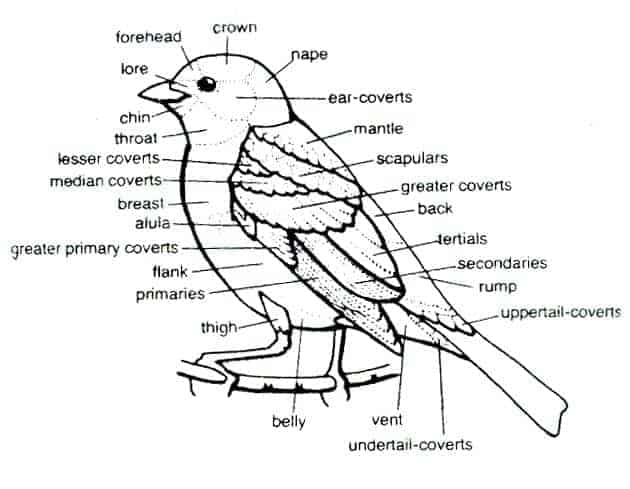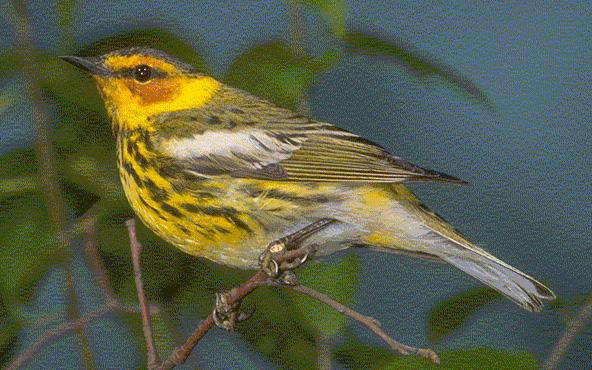What was That? Strange new birds come to our feeders. Spring migration arrives — and colorful warblers appear for a day or two before continuing north. A vacation to visit friends in another state brings new memories — and new birds!
Watching birds is fun, but it is even more fun if you can put a name with the bird. Most of us know what a Robin looks like. We probably fed Mallard Ducks at the pond. We could even identify a Bald Eagle or a Canada Goose without much effort. But what do you do when something totally new appears?
Learning to identify birds can also be frustrating. Computer programs are incredibly helpful for identifying birds. You can enter a bird’s color, size, habitat and sound and then see photos of all the birds that match your description!
A field guide can help you attach a name to most of the birds you see. Field guides are books with pictures and descriptions of the birds. A field guide typically shows birds of just one country or even one region of a country. You will soon learn that many of the birds you see just can’t be identified with 100% certainty. But with practice, you should at least be able to narrow your ID down to the correct family — was it a Sparrow or a Thrush?
You are about to discover that birders seem to have given a name to every inch on a bird’s body. Do you know where to find a bird’s wing bars, primaries, superciliary and malar stripe? These diagrams will help:
Parts of a Bird (click to see diagrams):
Head
Body
Wings
Glossary — Use this Glossary to look up words that describe parts of a bird.
Here are some tips to make identifying birds easier. First ask “How big is the bird?” Is it as big as a sparrow, a robin, a pigeon, a chicken or an ostrich? Is the bird fat or skinny, long or short. Look at each part of the bird. Is its bill short or long, thick or thin, curved or straight? How about the tail? What shape is it? Is it forked? Are the bird’s wings pointed or curved, long or short?
After you do all this, then notice the main colors of the bird. This sounds crazy, but it works. If you do not believe it, turn to the Roadside silhouettes inside the front cover of your Peterson Field Guide to Eastern Birds or Peterson Field Guide to Western Birds. With practice, you will be able to recognize all these birds just by their silhouette.
The colors of a bird can play tricks on you. A bird’s colors look different when the bird is at the top of a tree at sunset than it does at noon. Check the color of each major body part. Sometimes just the color of a bird’s legs can help you tell one species from another. Also check to see if the bird has wing bars or an eye-ring or a patch of color on its rump. Many birds found near water have distinctive markings on their wings or tail.
Finally, look around you. Are you and the bird deep in a forest, on your lawn or 50 miles out at sea? Each bird likes a certain habitat. Habitat refers to things like plants and trees in the area, the elevation (are you in the mountains or at the shore?), the climate in the area and the type of water nearby. See if the bird is swimming or wading. Can the bird climb trees? Does it wag its tail a lot? When it flies, does it go straight or up and down like a baby roller coaster?
If you can answer many of these questions, you have a very good chance of finding your bird in the field guide. There is a nice app called Merlin that you can download to your phone. It can help you a lot with bird identification. An even better resource is the Identification Wizard included in Thayer’s Birds of North America version 7.7. When you realize that your field guide arranges all of the birds in taxonomic order, it will become even easier to quickly turn to the right page and find your bird. Here is a hint: little birds you see in trees will usually be found in the back half of your field guide.
Here is one final secret you need to know. Really good birders can “see” more birds with their eyes closed than you and I can see with our eyes open! They know the songs a bird sings. Even one chip note might tell them a bird called a Rose-breasted Grosbeak is hiding in the bushes. What we need to learn is… LISTEN ! A bird’s song can tell you to START LOOKING FOR ME. Some birds such as rails and bitterns live deep in the swamp. You may never see them. But good birders can identify them just by hearing their call or their song. There is an amazing web site called Xeno-Canto.org with thousands of bird songs available.
Learning to identify birds is easier if you become familiar with the birds in your yard. As you get better at bird identification, you can expand to birds in your home town… your state… your country… the WORLD !!
Identify birds by COLOR
Identify birds by HABITAT
Identify birds by SIZE
Identify birds by BEHAVIOR
Identify birds by LOCATION

